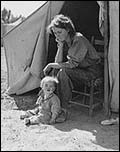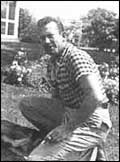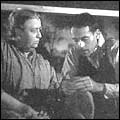 |
The Grapes of Wrath
 Listen to Brian Naylor's report Listen to Brian Naylor's report
 Listen to Woody Guthrie's 1940 song "Tom Joad" about the Grapes of Wrath Listen to Woody Guthrie's 1940 song "Tom Joad" about the Grapes of Wrath
 Watch a scene from the 1940 film The Grapes of Wrath Watch a scene from the 1940 film The Grapes of Wrath
|
Feb. 25, 2002 -- John Steinbeck arrived at the migrant camps in northern California in the late 1930s with little experience as a political writer. What he found stirred enough anger to convince him to take on the topic in what would become his most famous novel, The Grapes of Wrath.
For Morning Edition, NPR's Brian Naylor reports on the story behind the creation of one of America's literary landmarks.
Even though Steinbeck was immediately inspired by the tough conditions workers endured, the writing process wasn't always easy. He destroyed his first attempt, a story called "The Oklahomans." Susan Shillinglaw, the director of the Center for Steinbeck Studies at San Jose State University, says that he wasn't easily discouraged.
"He was determined to tell the story, but I don't think he knew quite how to tell it because he was so appalled," she says. "I think it took him a long time to figure out the structure of The Grapes of Wrath."
Even so, he never stopped writing. During this period he composed letters and wrote in a journal, some of which was later published under the title Working Days: The Journals of the Grapes of Wrath 1938-1941. The majority of the work never reached publication, but Steinbeck didn't view writing as a means to an end.
"I feel good when I am doing it and better than when I am not," Steinbeck replied when asked why he wrote. "I find joy in the texture and tone and rhythm of words and sentences."
After another visit to the migrant camps for research, Steinbeck finally mapped the novel's course and gave himself a schedule of 100 days in which to finish it. His wife at the time, Carol, came up with the title -- from the lyrics of "The Battle Hymn of the Republic" ("Mine eyes have seen the glory of the coming of the Lord; He is trampling out the vintage where the grapes of wrath are stored... ") -- and typed up the manuscript as he wrote. What emerged became an instant hit. The story of the Joad family and its journey from the Dust Bowl to California sold nearly half a million copies in its first year of publication.
Critics hailed the 1939 novel and The Grapes of Wrath won a Pulitzer Prize. Steinbeck -- whose other works included Of Mice and Men, Cannery Row and East of Eden -- was awarded the Nobel Prize for literature in 1962.
But the book brought controversy as well as success. Detractors accused the author of everything from harboring communist sympathies to exaggeration of the conditions in migrant camps. The uproar drew the attention of Eleanor Roosevelt, who came to Steinbeck's defense, and eventually led to congressional hearings on migrant camp conditions and changes in labor laws.
Grapes continues to have an impact on society, both from political and artistic perspectives. Author T.C. Boyle published a book with a similar perspective in 1995 called The Tortilla Curtain, in which he shifts the focus from the challenges faced by the Dust Bowl migrant workers to the lives of contemporary Mexican immigrants. Boyle says that the effort Steinbeck made to remedy injustice inspired him to imagine a new reality in a world that hasn't changed as much as it would like to believe.
Boyle notes that it's not just the politics of the novel that have held up over time. He says that a large part of the success of The Grapes of Wrath is attributable to the fact that it's a great story, and an effectively written slice of American history.
"You can read (about the lives of migrant workers) in your textbook," he says, "but if you read it in Steinbeck's version, you get to live it and breathe it."
Other Resources
• Grapes of Wrath chapter summaries, character list, map of places mentioned.
• John Steinbeck chronology
• San Jose State University Center for Steinbeck Studies
• National Steinbeck Center
• The John Steinbeck Centennial Celebration
• Voices from the Dust Bowl at the Library of Congress
• PBS's Surviving the Dust Bowl
• Weedpatch Camp.
• Grapes of Wrath film review
• Excerpts from TC Boyle's The Tortilla Curtain
For Morning Edition, NPR's Brian Naylor reports on the story behind the creation of one of America's literary landmarks.
Even though Steinbeck was immediately inspired by the tough conditions workers endured, the writing process wasn't always easy. He destroyed his first attempt, a story called "The Oklahomans." Susan Shillinglaw, the director of the Center for Steinbeck Studies at San Jose State University, says that he wasn't easily discouraged.
"He was determined to tell the story, but I don't think he knew quite how to tell it because he was so appalled," she says. "I think it took him a long time to figure out the structure of The Grapes of Wrath."
Even so, he never stopped writing. During this period he composed letters and wrote in a journal, some of which was later published under the title Working Days: The Journals of the Grapes of Wrath 1938-1941. The majority of the work never reached publication, but Steinbeck didn't view writing as a means to an end.
"I feel good when I am doing it and better than when I am not," Steinbeck replied when asked why he wrote. "I find joy in the texture and tone and rhythm of words and sentences."
After another visit to the migrant camps for research, Steinbeck finally mapped the novel's course and gave himself a schedule of 100 days in which to finish it. His wife at the time, Carol, came up with the title -- from the lyrics of "The Battle Hymn of the Republic" ("Mine eyes have seen the glory of the coming of the Lord; He is trampling out the vintage where the grapes of wrath are stored... ") -- and typed up the manuscript as he wrote. What emerged became an instant hit. The story of the Joad family and its journey from the Dust Bowl to California sold nearly half a million copies in its first year of publication.
Critics hailed the 1939 novel and The Grapes of Wrath won a Pulitzer Prize. Steinbeck -- whose other works included Of Mice and Men, Cannery Row and East of Eden -- was awarded the Nobel Prize for literature in 1962.
But the book brought controversy as well as success. Detractors accused the author of everything from harboring communist sympathies to exaggeration of the conditions in migrant camps. The uproar drew the attention of Eleanor Roosevelt, who came to Steinbeck's defense, and eventually led to congressional hearings on migrant camp conditions and changes in labor laws.
Grapes continues to have an impact on society, both from political and artistic perspectives. Author T.C. Boyle published a book with a similar perspective in 1995 called The Tortilla Curtain, in which he shifts the focus from the challenges faced by the Dust Bowl migrant workers to the lives of contemporary Mexican immigrants. Boyle says that the effort Steinbeck made to remedy injustice inspired him to imagine a new reality in a world that hasn't changed as much as it would like to believe.
Boyle notes that it's not just the politics of the novel that have held up over time. He says that a large part of the success of The Grapes of Wrath is attributable to the fact that it's a great story, and an effectively written slice of American history.
"You can read (about the lives of migrant workers) in your textbook," he says, "but if you read it in Steinbeck's version, you get to live it and breathe it."
Other Resources
• Grapes of Wrath chapter summaries, character list, map of places mentioned.
• John Steinbeck chronology
• San Jose State University Center for Steinbeck Studies
• National Steinbeck Center
• The John Steinbeck Centennial Celebration
• Voices from the Dust Bowl at the Library of Congress
• PBS's Surviving the Dust Bowl
• Weedpatch Camp.
• Grapes of Wrath film review
• Excerpts from TC Boyle's The Tortilla Curtain


Scenes like this one, of an 18-year-old mother from Oklahoma at a California migrant camp, inspired Steinbeck's The Grapes of Wrath.
Photo: Dorothea Lange, 1937, Library of Congress
 John Steinbeck was physically exhausted when he completed the Grapes manuscript.
John Steinbeck was physically exhausted when he completed the Grapes manuscript.Photo: San Jose State University Center for Steinbeck Studies
 Henry Fonda as Tom Joad and Jane Darwell as Ma Joad in the 1940 John Ford film The Grapes of Wrath.
Henry Fonda as Tom Joad and Jane Darwell as Ma Joad in the 1940 John Ford film The Grapes of Wrath.Photo: © Twentieth Century Fox